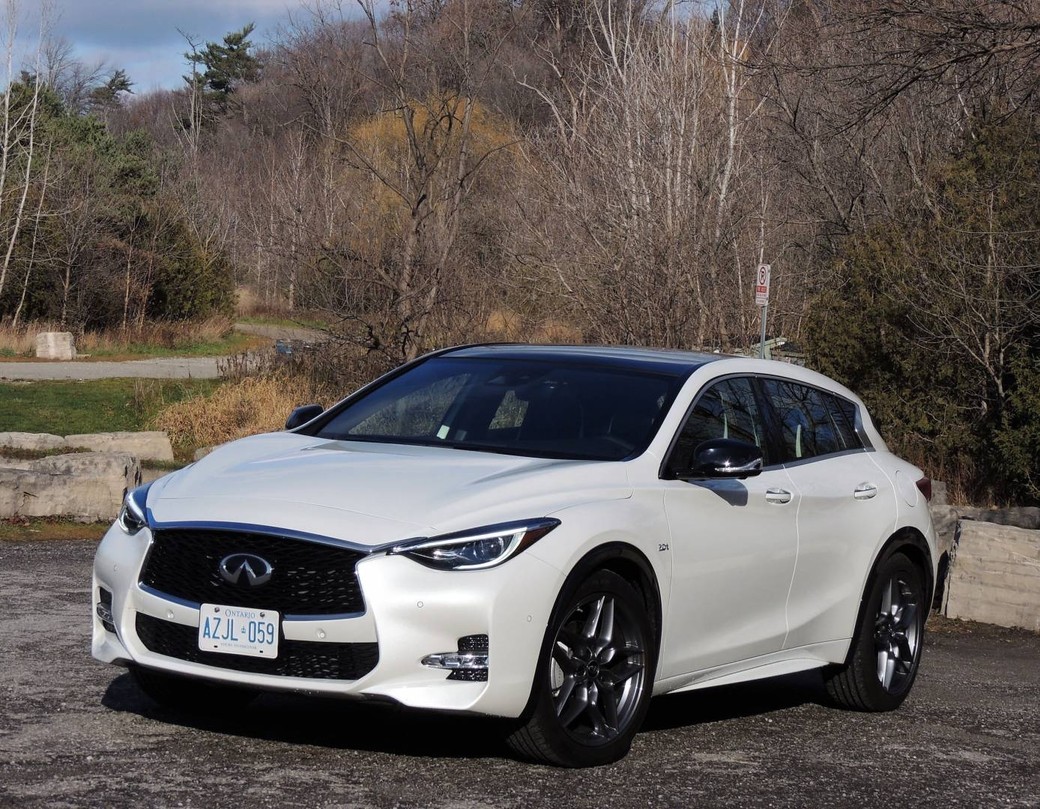
Infiniti QX30: hot hatch, sport wagon or crossover?
The Infiniti website calls its QX30 a “premium active crossover.”
I’m not quite sure what that means, as this compact auto could just as easily be labelled ‘hot hatch’ or ‘sport wagon.’ At least the creative department is being, well, ‘creative.’
But no matter what you call it, the QX30 doesn’t come up short on character. And although it shares a platform and powertrain with the Mercedes GLA, this Infiniti won’t be mistaken for its German rival.
The QX30 was developed as a unique entry into the C-segment – one of the fastest growing in the industry. It also creates an affordable entry point to the Infiniti lineup, with a base FWD model starting at $35,990.
Standard gear includes dual-zone climate control, seven-inch infotainment with six-speaker audio, smart key, heated eight-way power front seats with memory, Nappa leather upholstery, rear-view monitor and 18-inch alloy wheels.
Indeed, you do get a lot starting at $36K, but what I like about this vehicle isn’t so much about content for the dollar as it is about style. The QX30 is fetching.
It has a taller stance than a typical hatchback/wagon, yet appears muscular and low-slung, thanks to a combination of high beltline and low rear-sloping roofline. This is augmented by a double-wave aluminum hood, sculpted fenders and bodysides, and on the Sport model, unique front and rear lower fascias.
The QX30 also retains signature Infiniti cues like the double-arch front grille and crescent-cut C-pillars. Dual exhaust finishers – dark chrome on the Sport – are a nice touch.
Eighteen-inch alloys are standard, nineteens are optional, and these big wheels are shod with wide, low-profile rubber that tends more to the performance side. But ride isn’t harsh. Thanks in part to a fully independent suspension that is forgiving enough on rough asphalt, yet minimizes body roll on hard cornering.
Which is not to say it would be the vehicle of choice for hard-core enthusiasts. Like most competitors in this segment, QX30’s mechanicals and driving dynamics have been engineered to deliver the balance of performance and comfort demanded by premium buyers.

At its core is a powertrain built by Daimler, but tuned for Infiniti. This 2.0-litre turbocharged four cylinder is rated at 208 hp and 258 lb/ft of torque. The numbers may not sound extreme, but keep in mind that peak torque begins at an uber-low 1,200 rpm all the way to 4,400, and that QX30 tips the scales at only 1,500 kg.
Hence, takeoff is quick, with barely a hint of turbo lag, along with some wheel hop in front-wheel-drive models. Like my ‘Sport’ tester.
The engine is mated to a seven-speed, dual clutch automatic (with paddle shifters) that preselects cogs so the next shift is always ready to go. Unlike some DCTs, which can be abrupt, this one fires off gears quickly and smoothly – especially in ‘sport’ mode.
My top choice in the three-model lineup would be the middle child. At $38,490, the QX30 AWD is relatively small price walk from the $35,990 base unit, compared to $46,490 for Sport trim.
I’m puzzled as to why the latter doesn’t get drive to all four wheels, but it’s apparent that the extra dollars are plowed into a pile of upgrades, like bigger brakes, parking sensors, panoramic sunroof, active front headlights, navigation, around-view monitor, radar cruise control, and Bose 10-speaker premium audio.
All that, and safety tech that includes blind spot and lane departure warning, and forward emergency braking.

Despite being an entry model, the QX30 doesn’t cheap out on the interior. In addition to the standard Nappa leather mentioned above, my Sport model included LED ambient lighting, aluminum pedals and kickplates, flat-bottom steering wheel, and “Dinamica” headliner.
In case you’re wondering, Dinamica is a suede-like faux hide originally developed for the fashion industry.
Other flourishes include satin chrome brightwork around air vents and door panels, and high-contrast double-stitching throughout the dash, centre console and seats, which in my vehicle also included piping and cream-coloured accents to break up the abundance of black.
For a while now, I’ve been a fan of Nissan/Infiniti’s “Zero Gravity” seats. These are engineered to match the curvature of the spine and better distribute your weight.
Do they make the QX30 a great long-hauler?
Not sure, but I once spent nine days straight, driving from Chicago to Santa Monica, in a lower-priced Nissan – and my backside wasn’t in agony.
The “InTouch” infotainment system controls audio, navigation and vehicle settings, and like so many today, is as intuitive as your tablet and smart phone. Still, I appreciate that Infiniti still provides proper knobs and buttons for climate and audio.
It’s a superior way of controlling often-used functions, rather than taking eyes off the road to peck your way through menus on a touchscreen.
Any negatives?

Other than not offering AWD in a $46K vehicle, the QX30’s back seats are a little snug. If you’re much over five-foot-eight, head and leg room will be tight.
Cargo isn’t bad, however, with a generous 543-litre rear hold. Drop the flat-folding back bench, and you’ll find enough space for a couple of bikes or a weekend of camping. There’s also a pass-through for longer objects like skis and lumber.
This kind of vehicle may lack the utility of compacts like Acura RDX and Lincoln MKC, but it’s really competing in the same space as BMW X1 and Audi Q3 where it’s more about panache than practicality.
And in the QX30, Infiniti delivers this for less dough than its Euro competition, making it worth a closer look.

SNAPSHOT: 2017 Infiniti QX30
BODY STYLE: premium compact crossover
ENGINE: 2.0-litre turbocharged inline four cylinder (208 hp, 258 lb/ft)
TRANSMISSION: seven-speed automatic with manual shift mode; as tested with FWD, available with AWD
FUEL ECONOMY: (as tested) 9.7/7.1 litres/100 km (city/hwy)
CARGO: 543 litres
PRICING: Base (FWD) $35,990, AWD $38,490, Sport (as tested) $46,490, not including options, freight and taxes
WEBSITE: infiniti.ca







